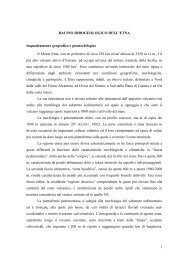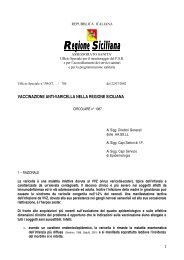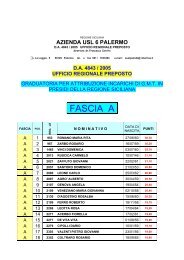THE MOZIA CHARIOTEER
THE MOZIA CHARIOTEER
THE MOZIA CHARIOTEER
Create successful ePaper yourself
Turn your PDF publications into a flip-book with our unique Google optimized e-Paper software.
<strong>THE</strong> <strong>MOZIA</strong> <strong>CHARIOTEER</strong><br />
This extraordinary masterpiece of Classical<br />
marble statuary was discovered at Mozia, the earliest<br />
Phoenician colony in Sicily. It is unique within the<br />
context of fifth-century Sikeliote and Magna Graecian<br />
and even mainland Greece culture, owing to the<br />
contrast between the severe form of the head and the<br />
calligraphic rendering of the folds of the clothing, the<br />
unusual dynamism of the figure-arising principally<br />
from the torsion of the bust-and the exceptional<br />
sensuality suffusing the figure. These qualities have<br />
made the statue the subject of heated debate since its<br />
discovery, and as a result the hypotheses concerning<br />
the iconography, dating, context, and the artist who<br />
created it have varied and are often conflicting.<br />
Another factor that has complicated the<br />
interpretation is where it was found: a major city of<br />
the Phoenician West, which certain scholars are<br />
disinclined to believe could have fostered works of<br />
such importance and so strongly representative of the<br />
culture and ideology of the Greek world. Given this,<br />
and taking the sculpture as an emblematic example of<br />
the mixing of Punic and Greek cultures typical of the<br />
Mozia area, some have identified it as the commission of a Greek artist to depict a figure belonging to the Phoenician-<br />
Punic cultural sphere. The subject represented in this case has been identified as an Eastern priest or deity such as<br />
Baal, whose many epithets include “divine charioteer,” or even Herakles-Melqart, whose iconography is well known in<br />
the East and in Cyprus.<br />
Although these hypotheses are rationally<br />
formulated and make a significant contribution to<br />
our knowledge of the iconographies of Eastern<br />
culture, scholars are now almost unanimous - at the<br />
current stage of the various iconographic, stylistic,<br />
and historical analyses of the statue - in identifying<br />
the figure as a victorious charioteer in the<br />
Panhellenic games, who stands in triumphant pose<br />
holding up a laurel wreath or some other symbol of<br />
victory. This interpretation gives rise to the<br />
intriguing hypothesis that the statue might<br />
originally have been part of a monument erected at<br />
Akragas to commemorate the Olympic victory won<br />
of the tyrant Theron in the chariot race in 476 B.C.,<br />
with the quadriga being driven by the charioteer<br />
Nikomachos. It has also been hypothesized,<br />
however, that the charioteer depicted might he<br />
Thrasyboulos of the Emmenids. The statue is<br />
therefore generally attributed to a major Greek<br />
master working during the period immediately<br />
preceding the mid-fifth century B.C., and it would<br />
have come to Mozia as part of the war spoils from<br />
one of the Carthaginian victories in the final years of<br />
the fifth century over the richest and most powerful<br />
Sikeliote cities of the time - Selinous, Himera,<br />
Akragas, and Gela.<br />
webmaster calogero baldanza
In contrast to the widespread acceptance among archaeologists and an historians of the identification of the<br />
figure as a charioteer, there are a number of different hypotheses regarding the cultural context in which the work<br />
was created and even the fifth-century dating. Some scholars have observed echoes of the works of the master<br />
craftsmen at Olympia; others see characteristic typical of late Ionian Archaism. More recently a workshop in Selinous<br />
has been proposed as the place where this exceptional and original version of the iconographic type of the charioteer<br />
was mated. This hypothesis takes into account the features typical of this colonial frontier city, whose material record<br />
continues to astonish with its extraordinary artistic expressions and the lively results obtained in other areas of<br />
production, such as figured terracottas. Selinous is in fact the “ideal” place for explaining the originality of our Statue,<br />
which, as mentioned, has no equal in the category of works to which it belongs.<br />
It is not possible to present here, for reasons of space, al1 the hypotheses that have been formulated over the<br />
years, beginning with the identification of the iconography of the work, but the context in which the sculpture was<br />
discovered can be outlined briefly. The statue was found on October 26, 1976, in the northeast sector of the island of<br />
Mozia during excavations in a potters’ workshop (Zone K) and its immediate surroundings. It was lying on its back on<br />
the hard-earth floor of a large open-air area, situated between the workshop and the “Cappiddazzu” sanctuary, and<br />
was found amid a great accumulation of detritus, stones, and earth. The topographic and stratigraphic data seem to<br />
indicate that this accumulation, which extended over the<br />
entire open-air area, constituted a sort of barricade, of<br />
which there was another nearby and parallel to it, created<br />
by the Mozians with building rubble, large architectural<br />
fragments, and miscellaneous materials. Before the<br />
extension of the excavations to the east (Zone K-east), the<br />
context in which the Statue was discovered suggested a<br />
terminus ante quem within the first decade of the fourth<br />
century B.C. On the basis of excavation data gathered<br />
later, however, it seems more likely that these barricades<br />
were raised during - not after - the siege of Mozia by<br />
Dionysos of Syracuse in 397 B.C., which ended with the<br />
destruction of the city.<br />
The statue’s head was detached from the body hut<br />
resting in place, a sign that the break had been caused by<br />
the pressure of the earth. The absence of the arms, metal<br />
accessories, and base clearly indicate, however, that the<br />
statue was not in situ. Most probably it was erected in the<br />
nearby sanctuary and was taken to the place of discovery<br />
after being knocked down during the siege. It seems<br />
plausible that the Mozians, in hastily amassing rubble,<br />
pieces of crumbling buildings, precious materials such as a<br />
huge votive stone anchor, architectural elements including<br />
a capital in proto-Aeolian style, a large quantity of “acorn”<br />
missiles, and, not least, the statue, hoped perhaps to<br />
salvage these materials at the end of the fighting. The<br />
following year, Mozia was re-conquered by Carthage, but<br />
the barricades remained as we found them.<br />
Maria Luisa Famà<br />
The statue belongs to the State Heritage and is in the possession of the Sicilian Region. Like many other finds from<br />
excavations conducted since the 1960’s, the statue is exhibited in the Giuseppe Whitaker Museum on the island of<br />
Mozia.<br />
Mozia and its Museum, together with the materials in the Whitaker collection, objects excavated in the early 1900’s by<br />
Joseph Whitaker, are all part of the Whitaker Foundation. Established in 1975, under the auspices of the National<br />
Academy of Lincei, its aim is to "increase cultural activities in Sicily, with particular reference to the study of the<br />
Phoenician-Punic culture, and to maintain the historical and artistic heritage that is protected on the island of Mozia."<br />
webmaster calogero baldanza

















